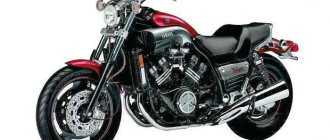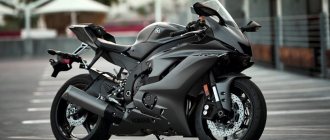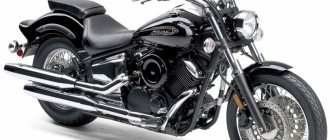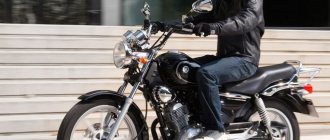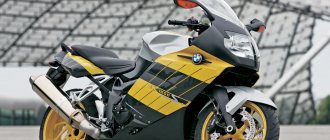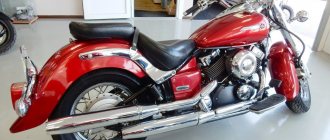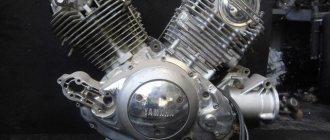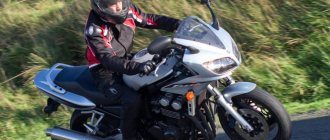Appearing at the end of the last century, the Yamaha R6 motorcycle quickly acquired cult status . It replaced the discontinued Thundercat, a popular but outdated sportbike, and became an excellent choice for those fans of high speeds and adrenaline who do not want to buy a “liter”. Over time, it has undergone many changes and has been repeatedly refined and improved. And don’t let the average cubic capacity deceive you - it is not intended for beginners . This plastic rocket can give you a whole lot of adrenaline, but it's not easy to control.
Design
During numerous upgrades, the Yamaha YZF R6 changed its appearance many times, although its general features remained recognizable. Predatorily narrowed, elongated headlights, a convex windshield, a compact and lean silhouette. Everything changed in 2022, when another restyling was carried out, and the bike became similar to its older brother, the YZF-R1. It must be admitted that, despite a certain loss of individuality, these cosmetic changes did him good, refreshing the design and making it more modern, which is clearly visible from the photo.
Specifications
By releasing the 600cc and 1000cc models in parallel, Yamaha engineers applied the most advanced technologies to both of them. The bike turned out to be not only balanced, but also incredibly powerful, and its technical characteristics can put almost anyone to shame. If compromises are not your thing, but a liter sportbike seems too big and heavy for you, the Yamaha YZF R6 will be the perfect option for you.
Engine
The engine that was originally installed in 2001 was slightly modified, and then acquired an injector along with four carburetors. Subsequently, it was modernized several more times, receiving an inertial supercharging system that adds power at high speed, different operating modes and an increased compression ratio. At the same time, the power ultimately did not increase, but even decreased slightly - in the first generation it is 120 hp. , and the latter has 118.4 hp. , and it is achieved at around 13000-14500 rpm . Torque ranges from 68 to 61 Nm , it is available at 10500-12500 rpm, so the engine needs to be constantly revved. Acceleration to 100 km/h takes only 3 seconds! At the same time, the R6's maximum speed is only slightly inferior to that of the YZF-R1, officially amounting to 260 km/h .
Transmission
The modern 6-speed transmission with slipper clutch works perfectly, shifting gears is easy and very precise. At the same time, the gearbox foot has a short stroke, which may at first seem unusual for motorcyclists who have switched from another vehicle. And it’s worth keeping in mind that the YZF-R6 is more demanding when it comes to choosing the right gear than the YZF-R1. After all, how many cubes do they both have? That’s the difference - with a smaller volume, the engine has to be turned more actively, and the gearbox has to be worked more often.
Chassis and brakes
The alloy Deltabox frame with a lightweight swingarm has been changed several times, but on any generation of the motorcycle it is completely consistent with its time. The suspension is fully adjustable both front and rear, and since 2005 an inverted fork has been installed. The brakes are very tenacious, on the front wheel there are two discs (from 298 to 320 mm) with 4-piston calipers , and on the rear there is another 220 mm disc with a 1-piston caliper (on older examples - with a 2-piston caliper). The ABS system is only installed on motorcycles produced in 2017 and younger.
Electronics
Older copies have little electronic filling, but the younger the bike, the more there is. Starting in 2022, there are even more electronics due to the addition of auxiliary traction control systems and selection of engine operating modes. For diagnostics, you need to connect the motorcycle to a laptop with special software via the CAN bus.
Weight and dimensions
The curb weight ranges from 182 to 190 kg , but in any case remains low. Despite its not too low center of gravity, the R6 doesn't feel heavy and is very easy to handle. The compact dimensions also make a positive contribution, thanks to which the bike feels like a fish in water in dense city traffic.
Controllability
All generations of the Yamaha R6 handle superbly, and in the city they feel even more confident than the “liter” ones, thanks to their more modest dimensions and comparable dynamics. In reviews and feedback from owners, complaints arise only about the 2005-2006 models, which, according to pilots, have a tendency to skid the rear wheel during sudden braking.
Fuel consumption
This parameter directly depends on the year of manufacture (more precisely, on the generation) of the motorcycle, its technical condition, operating conditions and riding style. Modern injection R6s from 2018 consume an average of 5.6 liters per 100 km , and for some R6 from 2003 this parameter will be a liter and a half more, especially if you drive aggressively. Tank volume is from 17 to 17.5 liters , depending on the generation.
Test drive YamahaYZF-R6
How it was…
1998.
In the fall, a new model from Yamaha was shown in Munich, a real revolution in the 600 class. Instantly putting its main competitor, the Honda CBR 600, on two shoulders, the Yamaha R6 became the sportiest bike. The lightest, most powerful in the class, the shortest wheelbase, the best brakes, an elegant rear with an LED light, a removable mudguard with space for a number, they clearly said that this motorcycle does not suit numbers. Compared to the R6, the competitors' 600s looked like road warriors. The Yamaha R6 follows the same path of ultra-sportiness that its “big sister” R1 paved a year ago.
The competitors realized that they had missed the mark and rushed to catch up: in a couple of years, the Kawasaki ZX6 and Suzuki GSXR 600 improved in power, lost weight, and Yamaha’s advantage began to melt away. It's time to update!
2001. The weight of the motorcycle has been reduced by 1.5 kg, there are new pistons, and minor changes have been made to the electrical equipment.
2003. In general, a new motorcycle with a modernized engine and a new chassis was released. Fuel injection instead of the throwback carburetors is the most memorable change. Motorcycles are now called “injection” or “carburetor” in conversations. Together with the injection, 3 hp were added, and the “diet” allowed me to lose another 5 kg.
2005. Among the clearly visible changes: an “inverted” fork, among the invisible ones - a different angle of inclination, a different radiator, new levers in the rear suspension to change the progression. Naturally, all improvements are designed to improve handling, which was not satisfactory before.
2006. Completely new motorcycle. None of the competitors have “Six Hundred” of this level. The first thing that catches your eyes and ears is the engine, which “spins” up to 18,000 rpm and produces 133 hp. Fantastic! Such a rev range is a Formula 1 privilege. To obtain such characteristics, the designers had to make an “ultra-short-stroke” engine with titanium valves, a direct-flow muffler and a tuned intake. There is no hiding that the R6 was built for the race track, to win in the Supersport class. Suspension with low and high speed damping adjustment is a pure racing necessity. Until now, you would not have seen such a suspension on anyone, even at the World Championships, because changing the fork is prohibited by the regulations. Now Yamaha has this homologated package, which makes everyone swallow their saliva even before the start. But what can we say about the “six hundred”, if you won’t find a two-speed suspension in the “standard” of either Ducati or MV Augusta, and on motorcycles that cost three times as much.
We decided to compare three generations of the R6, for which we took a carburetor motorcycle (2001), an injection motorcycle (2003), and the newest one, 2006. From the point of view of an ordinary consumer, what has changed in him over 7 years of evolution? If you look at the appearance, the first two motorcycles are very similar, but the new one already flaunts completely different shapes. The first appearance of the younger “Erka” in the 99th year of the last century made a vivid impression; I especially remember the unusual solution for that time: a removable place for a room. Motorcycles still look modern today, but that’s unless the latest model is standing next to them. In 2006, the place for the number was performed in such a way that it is impossible to watch and not smile. It’s very beautiful, and you want to unscrew it on the first day, then all that remains is a narrow strip of plastic and the passenger seat slapped to it. Ahead, the new “muzzle” reminded me of the predator that Schwarzenegger was chasing in one of the films, only the mouth of the motorcycle is designed to devour air. Need more air! Then eight injectors, working at full strength, will prepare the mixture, and it will instantly burn in the cylinders, push the piston and fly out into the pipe with a roar. And this will happen up to 300 times per second! Insane inertial load on the pistons, connecting rods, valves, but the modern technological level of production in the concern makes it possible to launch such an engine “to the masses.”
The most interesting part of the test is, naturally, the riding process, and not the study of the technical delights with which the motorcycle shines. It so happened that a few days before the test, I drove around the city in a carburetor-powered Erke, managed to get used to it, and get used to its character. The easier it will be to notice the difference with later models. I sit on the 2003 model and note the pleasant, easy start of the engine, yet the injector is superior to carburetors in terms of stability. The fit is exactly the same, there may be a slight difference, but it’s impossible to describe. In motion, the carburetor and injection models are absolutely identical and sharp in a modern way. The chassis makes it easy to change direction and encourages you to go fast. Yes, it’s not a “liter”; to go fast, you need to “turn the engine” and not lower the tachometer needle below o. The engines have similar characteristics: up to 5000 rpm, the output is very sluggish, it is difficult to overtake a car in traffic. From 5 to 8 thousand there is a noticeable pickup. This is already the range in which you can drive normally. After 8 thousand, with a new surge of power, the engine reaches its “combat” mode and confidently turns over. If you specifically focus your attention, you will notice that the fuel-injected motorcycle is a little faster, and reacts a little sharper and more willingly to the gas. It is easier to climb into the “goat” from the start. The acceleration is the same, only the reactions are sharper and more pleasant. I remember when the 2003 Air Sixes appeared on the “ring,” they, thanks to the new chassis and lower weight, drove faster than the previous ones, but in the city, in real life, it is impossible to realize this potential.
What about the newest motorcycle? I sit down and immediately smile. If I sat down with my eyes closed, I would probably say that I sat on a “ring” motorcycle. The feeling is similar to sitting on a stool. The suspension is rigid and does not sway, the seat is hard and does not dent. The seating position is different, but it’s impossible to say for sure that the footpegs are noticeably higher or the handlebars are lower. It's just a different motorcycle, not a twin to the previous two. I glance at the tachometer, with a red zone of 18,000 (!), and again I smile, not so much at the beautiful number at the end, but at the location of the clutch cable. The cable passes through the loop provided for it and neatly closes the lower sector of the tachometer. Up to “4000” there is no need to look for the needle; to the number “5000” it will crawl out from behind the cable, and from 10 to 18 it will be at the top of the scale, right before your eyes. The characteristics of the engine can be predicted by how the tachometer is marked. So it is, before 2000 it is generally contraindicated to open the gas, this zone still refers to idle speed and in response to the load the engine rumbles very displeasedly. After 5 thousand there is a smooth increase in power, not even as obvious as on earlier models, and only after “ten” the engine starts singing, begins to “follow the handle”, and holding it in this mode is exactly what you need. In this range there is an advantage in power, and if you ride in the “up to 10,000” mode, then the new motorcycle is hardly more powerful. But the behavior of the chassis is very familiar. You can feel the design school! This is a typical R6, only prepared for racing. Everything works the same, only tougher and more stable. Driving through holes and joints is the same as before, not a bit harsher, and during shifts and on gentle waves it is much more stable. This is the merit of “smart” shock absorbers, where different valves and channels are responsible for damping sudden and smooth disturbances. This is all very good! But there are also disadvantages, and, unfortunately, more than one.
Noise! Have you ever heard how a motorcycle hums with an open filter box and a removed filter? In response to the opening of gas, a guttural roar and hissing of air in the diffusers is heard. It's a nice sound if you enjoy it for a minute and then close the box. The new Erka is always buzzing! After ten minutes of driving, I drove steadily and slowly, without opening the gas, because I was tired of listening to this sound; in response to the slightest movement of the throttle, the valves open and it seems that the intake resonance lives under the helmet, and is not hidden under the tank. No forward flow can compare with this intake in terms of its effect on the driver’s brain. True, after the treasured 10 thousand, the rumble merges into a howl and is no longer so annoying, but 5-10 thousand is the most urban range. You can drive on the “ring” with “earplugs”, and few people are interested in what kind of noise there is from the intake or exhaust. In the city the “gayets” whistles, but you don’t hear it, so who can you tell later that your ears were plugged.
An excellent, hard, racing seat perfectly informs the driver that what is under the wheels is a plus, which after half an hour of driving turns into a minus. I don’t know about anyone, but the seat made me feel uncomfortable. Again, on the “ring”, where the race or training lasts 20-40 minutes, and where you can only sit on straight lines, it’s unlikely that anyone will complain about excessive rigidity. Very unusual and beautiful, the faceted side fairing has an aesthetic and probably aerodynamic advantage, but at the same time it has a big ergonomic disadvantage. The knees lie exactly on the sharp edges. Having a habit of squeezing the motorcycle with my knees, I quickly unlearned it on this motorcycle. Jeans hurt my knees. Surely, in overalls with protective knee pads, the edges will not cut into them. But even the most avid sport biker sometimes rides a motorcycle in jeans. I specifically switched to the previous model and noted how comfortably the knees fit on the frame, and the fairing starts lower.
I wanted to tell you how controversial the new motorcycle is. But he is just unambiguous. This is a ready-made motorcycle for track days, which are popular in the West and not yet developed here. I was on the days of free skating on the western slopes, when whole families come for the weekend, bring motorcycles on trailers, barbecue and ride along the track where Rossi performed yesterday. The new R6 is just right for this. If you’re just driving around the city, then I would prefer the 2005 model; it’s not for nothing that the Japanese left it in the production program and are releasing both in parallel.
Text: Valery Garbaruk, Kyiv
Photo: michel
Motorcycle price
The cost of the cheapest copies, about 15-20 years old, starts from 180-200 thousand rubles . It is worth keeping in mind that the cheapest offers often have hidden defects, and they need to be checked especially carefully. Well, a completely new Yamaha R6 will cost 1 million rubles and more - these are the current prices at official dealers.
Repair and tuning
How often you will have to spend money on your two-wheeled friend, and how much money will be spent, greatly depends on the operating conditions of the motorcycle. If you drive as usual, then you will spend less, but with regular races on the track, repairs and maintenance will require completely different amounts.
Repair
The Yamaha YZF R6 is not highly maintainable, and many components in it, in the event of a breakdown, can only be replaced and not repaired. This results in the high cost of maintaining the model and the complexity of many service operations. In addition, the latest generations of sport bikes contain a lot of complex electronics, which only experienced mechanics with a laptop and special software can understand. To carry out full diagnostics, you need to connect the “brains” of the bike to a computer and analyze all the data.
Spare parts
The compatibility of spare parts between different generations of a motorcycle is far from 100%, and it is often difficult to find the necessary parts for old Yamaha YuZF R 6. Everything is available to order, but the price may surprise you. But there are few non-original spare parts, despite the popularity of the model and the fact that the market is full of non-original consumables. Their quality ranges from excellent to dismal.
Tuning
The range of available tuning is huge, it includes both cosmetic elements and purely technical ones. Refining the transmission, strengthening the engine, upgrading the brakes - whatever you want, there would be enough money. Moreover, most of this stuff is offered by third-party manufacturers, and not by Yamaha itself.
Model dimensions
If we talk about the weight of the Yamaha YZF R6, then the model is relatively light . Its weight reaches only 166 kg. A lightweight diamond-shaped frame made it possible to achieve this figure, which adds additional speed and aerodynamics to the bike. The dimensions of the model look like this:
- length – 204 cm;
- width – 70.5 cm;
- height – 110 cm.
Motorcycle modifications
The sportbike has been changed several times, and now the seventh generation is being sold in dealerships, which will be released in 2022. Below are the main changes to the model by year:
- Yamaha R6 2001. A lot of minor changes to the engine, affecting pistons, connecting rods, ignition and much more. They were considered successful, and the 2002 Yamaha R6 was produced in exactly the same form.
- Yamaha R6 2004 model year (production actually began in 2003) acquired an injector instead of carburetors, as well as an updated appearance.
- Yamaha R6 2006. Another deep restyling with creatively recycled plastic and an engine with increased power (up to 127 hp). The modernization also affected other elements - exhaust, headlight, gas tank, injector and gearbox. The clutch became slippery and the mechanical throttle was replaced with an electronic one. The ignition system has also been completely replaced with a new one. There were some minor flaws, but in the Yamaha R6 2007 they were all corrected.
- In 2008 and 2010, restylings were carried out, but there were no significant changes in the technical part.
- The 2022 Yamaha R6 has received the most profound changes in the model's history. The design was completely redesigned, the bike received a new suspension, stronger brakes, an aerodynamic body kit, auxiliary electronic systems and much more.
Main advantages of the model
Among the reasons why the R6 Yamaha has gained wide popularity are:
- electrically adjustable throttle;
- an inverted fork;
- powerful engine with 129 horsepower;
- excellent handling;
- good aerodynamics.
You may also be interested in: Motocross: champions of cross-country motorcycles
Advantages and disadvantages
All generations of the Yamaha R6 differ from each other to one degree or another, but in general the direction of development of this model has not changed for years. This is a super-powerful medium-sized sportbike, its element is the racing track, and all its strengths and weaknesses stem precisely from this circumstance. You don’t expect the comfort of a “Gold Wing” or suspension like some kind of touring bike from racing equipment, do you?
Advantages
- Crazy acceleration dynamics , up to 200 km/h, not inferior to that of the YZF-R1.
- Modest weight , which, coupled with compact dimensions and overall balance, provides excellent maneuverability.
- Unique design , recognizable and very stylish.
- gas tank and long range.
Flaws
- The motorcycle is poorly suited for stunting due to its engine lubrication system. When driving on the rear wheel, it quickly begins to starve of oil, and the engine fails.
- Expensive spare parts , as well as difficulties in finding some of them.
- Low maintainability. Many components cannot be repaired.
- Fragile and expensive plastic .
What do we end up with?
This motorbike is one of the most frequent participants in world championships, which once again confirms its quality. It is capable of phenomenal acceleration, which leaves many competitors far behind in the first seconds. At the same time, driving such a vehicle is more than easy.
Technical innovations such as an upgraded engine and an improved chassis make this Japanese motorcycle a true king of the track - and nothing is likely to change anytime soon.
And the appearance of the model is simply amazing. Just look at the photo of the Yamaha P6 to understand that this is one of the best sports bikes . Fast, powerful, lightweight - this model has a lot of advantages.
All this is confirmed by positive reviews about the motorcycle. As a result, the model is suitable for all sports bike lovers. It is worth noting that the model is not just made in a sporty style, but is designed specifically for racing - in the city the suspension behaves somewhat harshly. But on the track there is simply no equal to this bike.
Video review of the Yamaha R6 motorbike:
Owner reviews
I looked at six hundred sports cars for a long time, and among all the motorcycles I liked the R6 the most. As a result, I bought it, took it from my hands and drove the 2008 R6 to my city, 400 km away. The first impression is as if I saddled a wild mustang, slightly touched the throttle, and that’s it, there was a sharp teleportation forward. At first, sitting after the CBR 600 F4i was wildly uncomfortable; it felt like I was straddling the handle of a shovel. The pendants seemed oak, but then I reconfigured them to suit myself, and it became better. Over time, I got the hang of it, but now the bike is up for sale, I just want a sportbike, but still not so radical, comfort is absolutely lacking. Yuri, Novosibirsk.
Best in class and that's it! This is not the first motorcycle like this for me, first I had a Yamaha R6 2005 (crashed), then an R1 2003 (stolen from the parking lot), then I took the R6 2009, and I still ride it, this is the fourth season. I go to the track sometimes, but only occasionally, I don’t try to improve my lap times, I just ride for fun once a month. And so to work and back every day, plus trips at night and on weekends, everything suits me completely. Vitaly, Moscow.
I own a 2005 Yamaha R6, which, in my opinion, is the most interesting generation of all. It’s not as radical a sportbike as the versions before and after it, there are some distant sports-touring features - the seating is more comfortable, there’s more comfort, so I don’t want to change it to a more recent one. There is one minus, of all generations this is the rarest, so spare parts are difficult to find, only to order, everything is expensive. Well, the plastic is brittle, a slight fall shatters into 100,500 fragments, and the kit stands like an airplane wing. I saw Chinese analogues, but the quality there is very sad. Vadim, Kaluga.
Similar models
- Honda CBR 600RR. A fresh reincarnation of the famous series, not inferior to its competitors one gram.
- Suzuki GSX-R 600. It has a slightly friendlier and smoother character, which does not make it weaker than its rivals.
- Kawasaki ZX-6R. An incredibly popular model from an “evergreen” manufacturer, with a long history and a whole army of fans.
Suspension features
If we talk about the suspension, it is distinguished by its strength and reliability. At the front, an inverted telescopic fork was used, the travel of which reaches 115 mm. Such designs are used only for sports bikes. At the rear, you'll find a swingarm monoshock with 120mm of travel.
The chassis is designed to make turns as smooth and even as possible.
FAQ
- How noticeable is the difference in dynamics compared to the R1? At speeds up to 150-170 km, the difference is near zero, and it can be attributed to the reaction time of the pilots themselves. At higher speeds, the YZF-R1 begins to confidently pull ahead.
- I want to ride on the track and race at sea in the summer for a couple of thousand kilometers. Is this model right for me? Doubtful, unless you are a masochist. Some people even ride 50cc scooters across Russia, but this bike is not designed for long rides. Most drivers, after several hours behind the wheel, begin to ache in their back and arms, which are subjected to high loads due to a purely sporty riding position.
- Is it possible to turn off assistance systems like traction control? I don’t like it when technology tries to think and make decisions for me. It is possible, but it is not recommended. Japanese engineers are by no means fools, and they installed all this for a reason.
Conclusion
In most cases, “six hundred” cars are deservedly considered less demanding on driving skills than “liters”, but in the case of the Yamaha R6 this is not the case. Its unpredictable character and violent disposition are eloquently demonstrated by the torque curve with dips and pick-ups that can come as a surprise to an inexperienced pilot. To ride this motorcycle, and to do it safely, you need to know how to do it, and skill comes with age. We absolutely cannot recommend this sportbike to beginners . Leave it to experienced pilots who can tame it.
Specifications
| Maximum engine power: | 118.4 – (2018+) HP |
| Torque: | 61.7 Nm (6.3 kg*m) at 10500 rpm – (2017+) Nm |
| Working volume: | 599 cm3 |
| Motor type (cylinder arrangement, number of strokes): | 4-cylinder, 4-stroke, in-line |
| Number of cylinders: | 4 |
| Number of valves: | |
| Intake type (Injector / Carburetor): | |
| Bore and stroke: | |
| Starting system (Electric starter, kick starter): | |
| Maximum speed in km/h: | 260 km/h |
| Cooling system: | Liquid |
| Transmission (gearbox): | 6-speed, Manual |
| Clutch (Dry / Wet): | |
| Drive unit: | Chain |
| Frame: | Aluminum Deltabox |
| Chassis | |
| Suspension (front/rear travel): | |
| Brakes (Front/Rear): | |
| Wheels / Tires / Rubber: | |
| Dimensions and weight | |
| Dimensions (Length / Width): | |
| Seat height: | |
| Ground clearance: | |
| Curb weight: | |
| Wheelbase: | 1375 mm – (2018+) mm |
| Weight: | 190 kg – (2017+) kg |
| Fuel tank capacity: | 17 l. |
| Battery capacity: | |
| Year of release: | |
| Country of Origin: |
Brake system
The improved braking system of the latest Yamaha R6 model is also pleasing. The front brake discs have grown from 310 to 330 mm. A double-disc hydraulic device is responsible for braking here. A 220 mm diameter disc hydraulic system is installed at the rear. All this ensures fairly good quality brakes. The system is very sensitive and quickly responds to all driver actions. The settings of the anti-lock braking system also look good - the mechanism is activated at the right moment, so its early activation does not interfere with control.
